

Compact Muon Solenoid
LHC, CERN
| CMS-PAS-JME-17-001 | ||
| Performance of missing transverse momentum in proton-proton collisions at $\sqrt{s} = 13$ TeV using the CMS detector | ||
| CMS Collaboration | ||
| July 2018 | ||
| Abstract: The performance of algorithms for the reconstruction of missing transverse momentum for data from proton-proton collisions with a center-of-mass energy of 13 TeV collected with the CMS detector at the LHC is presented. The data sample corresponds to an integrated luminosity of 35.9 fb$^{-1}$. The results include detailed studies of the identification of events with anomalous missing transverse momentum and measurements of its scale and resolution. The performance of a missing transverse momentum reconstruction algorithm that mitigates the effects of multiple proton-proton interactions, using the Puppi method, is also presented. Lastly, the performance of an algorithm used to estimate the compatibility of the reconstructed missing transverse momentum with the null hypothesis is shown. | ||
|
Links:
CDS record (PDF) ;
CADI line (restricted) ;
These preliminary results are superseded in this paper, JINST 14 (2019) P07004. The superseded preliminary plots can be found here. |
||
| Figures | |

png pdf |
Figure 1:
Upper panel: Distributions of {\mathrm {Z}} boson {{q}_{\rm T}} in {{\mathrm {Z}}\to \mu ^+\mu ^-}(left) and {{\mathrm {Z}}\to e^+e^-}(right) samples. The last bin contains the overflow content. Lower panel: Data to simulation ratio. The gray band corresponds to the statistical uncertainty of the simulated samples. |

png pdf |
Figure 1-a:
Upper panel: Distributions of {\mathrm {Z}} boson {{q}_{\rm T}} in {{\mathrm {Z}}\to \mu ^+\mu ^-}(left) and {{\mathrm {Z}}\to e^+e^-}(right) samples. The last bin contains the overflow content. Lower panel: Data to simulation ratio. The gray band corresponds to the statistical uncertainty of the simulated samples. |
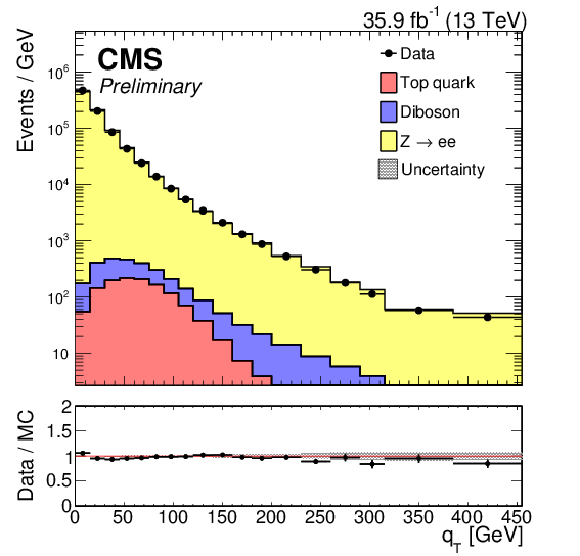
png pdf |
Figure 1-b:
Upper panel: Distributions of {\mathrm {Z}} boson {{q}_{\rm T}} in {{\mathrm {Z}}\to \mu ^+\mu ^-}(left) and {{\mathrm {Z}}\to e^+e^-}(right) samples. The last bin contains the overflow content. Lower panel: Data to simulation ratio. The gray band corresponds to the statistical uncertainty of the simulated samples. |
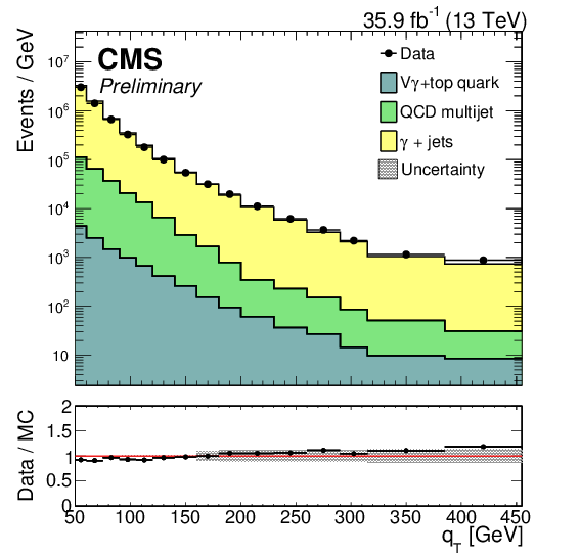
png pdf |
Figure 2:
Upper panel: Distribution of the photon {{q}_{\rm T}} in the single-photon sample. The last bin contains the overflow content. Lower panel: Data to simulation ratio. The gray band corresponds to the statistical uncertainty of the simulated samples. |
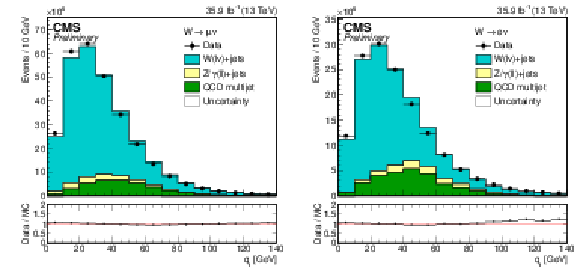
png pdf |
Figure 3:
Upper panel: Distributions of W boson {{q}_{\rm T}} in single-muon (left) and single-electron (right) samples. The last bin contains the overflow content. Lower panel: Data to simulation ratio. The gray band displays the systematic uncertainty due to the limited statistics of the simulated samples, the jet energy scale, jet energy resolution, and variations on the unclustered energy. |

png pdf |
Figure 3-a:
Upper panel: Distributions of W boson {{q}_{\rm T}} in single-muon (left) and single-electron (right) samples. The last bin contains the overflow content. Lower panel: Data to simulation ratio. The gray band displays the systematic uncertainty due to the limited statistics of the simulated samples, the jet energy scale, jet energy resolution, and variations on the unclustered energy. |

png pdf |
Figure 3-b:
Upper panel: Distributions of W boson {{q}_{\rm T}} in single-muon (left) and single-electron (right) samples. The last bin contains the overflow content. Lower panel: Data to simulation ratio. The gray band displays the systematic uncertainty due to the limited statistics of the simulated samples, the jet energy scale, jet energy resolution, and variations on the unclustered energy. |

png pdf |
Figure 4:
Event display for a beam halo event with collinear hits in the CSC (black), {{p_{\mathrm {T}}} ^\text {miss}} of 250 GeV and a jet of 232 GeV. The hadronic deposit is spread in $\eta $ but it is narrow in $\phi $. |

png pdf |
Figure 5:
The {{p_{\mathrm {T}}} ^\text {miss}} (left) and jet $\phi $ (right) distributions for events passing the dijet (left) and monojet (right) selection with the event cleaning algorithms applied, including that based on jet identification requirements (filled markers), without the event cleaning algorithms applied (open markers), and from simulation (filled histograms). |

png |
Figure 5-a:
The {{p_{\mathrm {T}}} ^\text {miss}} (left) and jet $\phi $ (right) distributions for events passing the dijet (left) and monojet (right) selection with the event cleaning algorithms applied, including that based on jet identification requirements (filled markers), without the event cleaning algorithms applied (open markers), and from simulation (filled histograms). |

png |
Figure 5-b:
The {{p_{\mathrm {T}}} ^\text {miss}} (left) and jet $\phi $ (right) distributions for events passing the dijet (left) and monojet (right) selection with the event cleaning algorithms applied, including that based on jet identification requirements (filled markers), without the event cleaning algorithms applied (open markers), and from simulation (filled histograms). |

png pdf |
Figure 6:
The {{p_{\mathrm {T}}} ^\text {miss}} trigger efficiency measured in the single-electron sample. The efficiency of each reconstruction algorithm, namely the L1, the calorimeter and the PF based {{p_{\mathrm {T}}} ^\text {miss}} algorithms, is shown separately. The numbers in parenthesis correspond to the online {{p_{\mathrm {T}}} ^\text {miss}} thresholds. |

png pdf |
Figure 7:
Illustration of {\mathrm {Z}} (left) and photon (right) event kinematics in the transverse plane. The vector {\mathaccentV {vec}17E{u}_{\rm T}} denotes the vectorial sum of all particles reconstructed in the event except for the two leptons from the {\mathrm {Z}} decay (left) or the photon (right). |

png |
Figure 7-a:
Illustration of {\mathrm {Z}} (left) and photon (right) event kinematics in the transverse plane. The vector {\mathaccentV {vec}17E{u}_{\rm T}} denotes the vectorial sum of all particles reconstructed in the event except for the two leptons from the {\mathrm {Z}} decay (left) or the photon (right). |
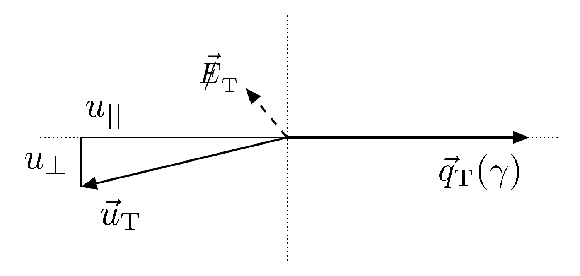
png |
Figure 7-b:
Illustration of {\mathrm {Z}} (left) and photon (right) event kinematics in the transverse plane. The vector {\mathaccentV {vec}17E{u}_{\rm T}} denotes the vectorial sum of all particles reconstructed in the event except for the two leptons from the {\mathrm {Z}} decay (left) or the photon (right). |

png pdf |
Figure 8:
Upper panel: Distributions of {{p_{\mathrm {T}}} ^\text {miss}} in {{\mathrm {Z}}\to \mu ^+\mu ^-}(top left), {{\mathrm {Z}}\to e^+e^-}(top right), and photon events (lower middle) in data and simulation. The last bin includes the overflow content. Lower panel: Data to simulation ratio. The systematic uncertainty due to the jet energy scale, jet energy resolution, and variations on the unclustered energy is displayed with a gray band. |
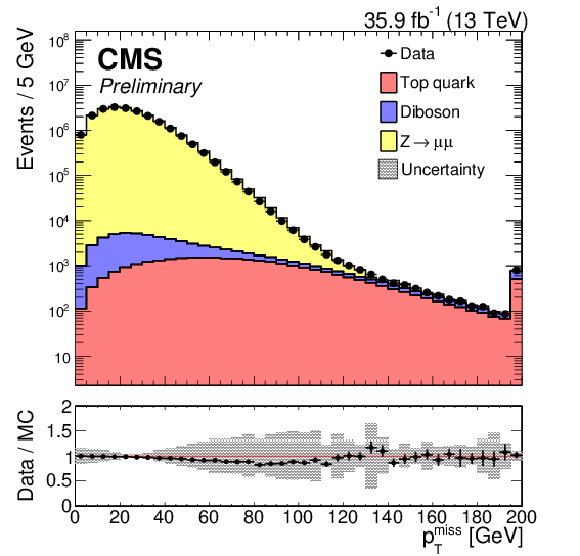
png pdf |
Figure 8-a:
Upper panel: Distributions of {{p_{\mathrm {T}}} ^\text {miss}} in {{\mathrm {Z}}\to \mu ^+\mu ^-}(top left), {{\mathrm {Z}}\to e^+e^-}(top right), and photon events (lower middle) in data and simulation. The last bin includes the overflow content. Lower panel: Data to simulation ratio. The systematic uncertainty due to the jet energy scale, jet energy resolution, and variations on the unclustered energy is displayed with a gray band. |
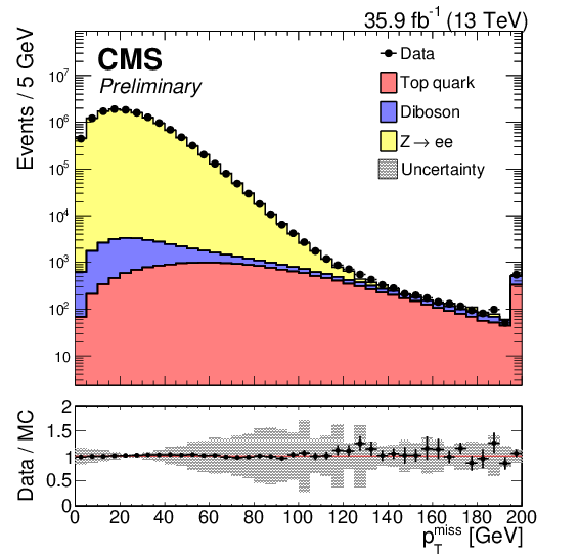
png pdf |
Figure 8-b:
Upper panel: Distributions of {{p_{\mathrm {T}}} ^\text {miss}} in {{\mathrm {Z}}\to \mu ^+\mu ^-}(top left), {{\mathrm {Z}}\to e^+e^-}(top right), and photon events (lower middle) in data and simulation. The last bin includes the overflow content. Lower panel: Data to simulation ratio. The systematic uncertainty due to the jet energy scale, jet energy resolution, and variations on the unclustered energy is displayed with a gray band. |
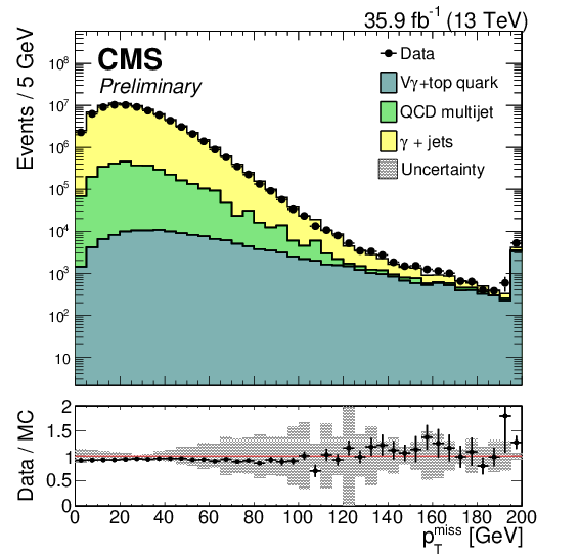
png pdf |
Figure 8-c:
Upper panel: Distributions of {{p_{\mathrm {T}}} ^\text {miss}} in {{\mathrm {Z}}\to \mu ^+\mu ^-}(top left), {{\mathrm {Z}}\to e^+e^-}(top right), and photon events (lower middle) in data and simulation. The last bin includes the overflow content. Lower panel: Data to simulation ratio. The systematic uncertainty due to the jet energy scale, jet energy resolution, and variations on the unclustered energy is displayed with a gray band. |
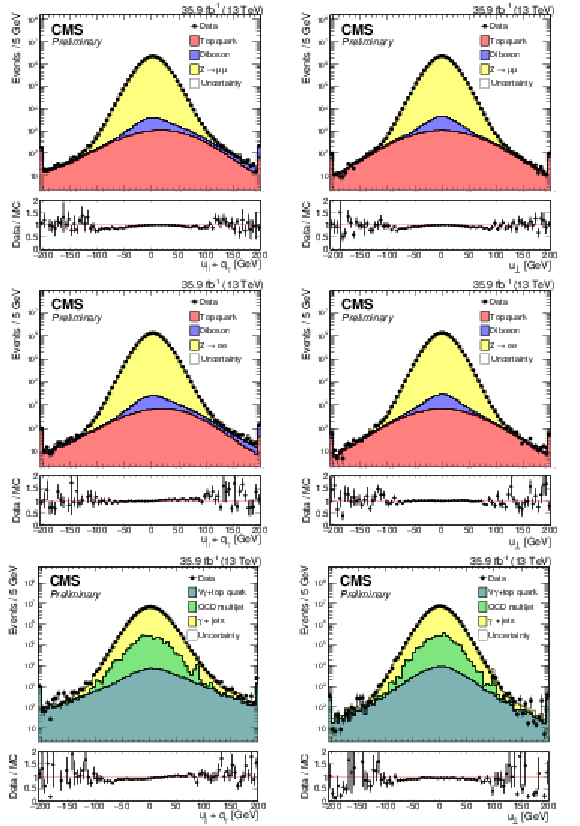
png pdf |
Figure 9:
Distribution of {u_{^\circ}limiter "026B30D} + {{q}_{\rm T}} and {u_\perp} components of the hadronic recoil, in data (filled markers) and simulation (solid histograms) in the {{\mathrm {Z}}\to \mu ^+\mu ^-}(upper), {{\mathrm {Z}}\to e^+e^-}(middle) and {\gamma} (lower) samples. The first and the last bins include the underflow and overflow content, respectively. The points in the lower panel of each plot show the data to simulation ratio. The systematic uncertainty due to the jet energy scale, jet energy resolution and variations on the unclustered energy is displayed with a gray band. |
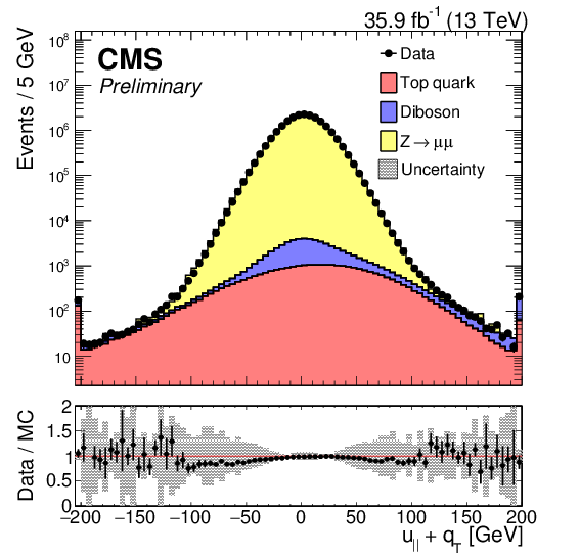
png pdf |
Figure 9-a:
Distribution of {u_{^\circ}limiter "026B30D} + {{q}_{\rm T}} and {u_\perp} components of the hadronic recoil, in data (filled markers) and simulation (solid histograms) in the {{\mathrm {Z}}\to \mu ^+\mu ^-}(upper), {{\mathrm {Z}}\to e^+e^-}(middle) and {\gamma} (lower) samples. The first and the last bins include the underflow and overflow content, respectively. The points in the lower panel of each plot show the data to simulation ratio. The systematic uncertainty due to the jet energy scale, jet energy resolution and variations on the unclustered energy is displayed with a gray band. |
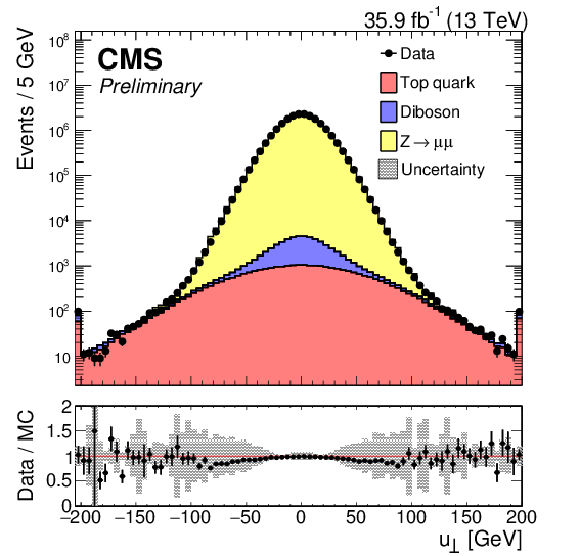
png pdf |
Figure 9-b:
Distribution of {u_{^\circ}limiter "026B30D} + {{q}_{\rm T}} and {u_\perp} components of the hadronic recoil, in data (filled markers) and simulation (solid histograms) in the {{\mathrm {Z}}\to \mu ^+\mu ^-}(upper), {{\mathrm {Z}}\to e^+e^-}(middle) and {\gamma} (lower) samples. The first and the last bins include the underflow and overflow content, respectively. The points in the lower panel of each plot show the data to simulation ratio. The systematic uncertainty due to the jet energy scale, jet energy resolution and variations on the unclustered energy is displayed with a gray band. |

png pdf |
Figure 9-c:
Distribution of {u_{^\circ}limiter "026B30D} + {{q}_{\rm T}} and {u_\perp} components of the hadronic recoil, in data (filled markers) and simulation (solid histograms) in the {{\mathrm {Z}}\to \mu ^+\mu ^-}(upper), {{\mathrm {Z}}\to e^+e^-}(middle) and {\gamma} (lower) samples. The first and the last bins include the underflow and overflow content, respectively. The points in the lower panel of each plot show the data to simulation ratio. The systematic uncertainty due to the jet energy scale, jet energy resolution and variations on the unclustered energy is displayed with a gray band. |

png pdf |
Figure 9-d:
Distribution of {u_{^\circ}limiter "026B30D} + {{q}_{\rm T}} and {u_\perp} components of the hadronic recoil, in data (filled markers) and simulation (solid histograms) in the {{\mathrm {Z}}\to \mu ^+\mu ^-}(upper), {{\mathrm {Z}}\to e^+e^-}(middle) and {\gamma} (lower) samples. The first and the last bins include the underflow and overflow content, respectively. The points in the lower panel of each plot show the data to simulation ratio. The systematic uncertainty due to the jet energy scale, jet energy resolution and variations on the unclustered energy is displayed with a gray band. |

png pdf |
Figure 9-e:
Distribution of {u_{^\circ}limiter "026B30D} + {{q}_{\rm T}} and {u_\perp} components of the hadronic recoil, in data (filled markers) and simulation (solid histograms) in the {{\mathrm {Z}}\to \mu ^+\mu ^-}(upper), {{\mathrm {Z}}\to e^+e^-}(middle) and {\gamma} (lower) samples. The first and the last bins include the underflow and overflow content, respectively. The points in the lower panel of each plot show the data to simulation ratio. The systematic uncertainty due to the jet energy scale, jet energy resolution and variations on the unclustered energy is displayed with a gray band. |

png pdf |
Figure 9-f:
Distribution of {u_{^\circ}limiter "026B30D} + {{q}_{\rm T}} and {u_\perp} components of the hadronic recoil, in data (filled markers) and simulation (solid histograms) in the {{\mathrm {Z}}\to \mu ^+\mu ^-}(upper), {{\mathrm {Z}}\to e^+e^-}(middle) and {\gamma} (lower) samples. The first and the last bins include the underflow and overflow content, respectively. The points in the lower panel of each plot show the data to simulation ratio. The systematic uncertainty due to the jet energy scale, jet energy resolution and variations on the unclustered energy is displayed with a gray band. |

png pdf |
Figure 10:
Upper panel: Response of {{p_{\mathrm {T}}} ^\text {miss}} in data in {{\mathrm {Z}}\to \mu ^+\mu ^-}, {{\mathrm {Z}}\to e^+e^-}and {\gamma} events. Lower panel: Ratio of the {{p_{\mathrm {T}}} ^\text {miss}} response in data and simulation. The gray band corresponds to the systematic uncertainty due to the jet energy scale, jet energy resolution and variations on the unclustered energy, estimated from the {{\mathrm {Z}}\to e^+e^-}sample. |
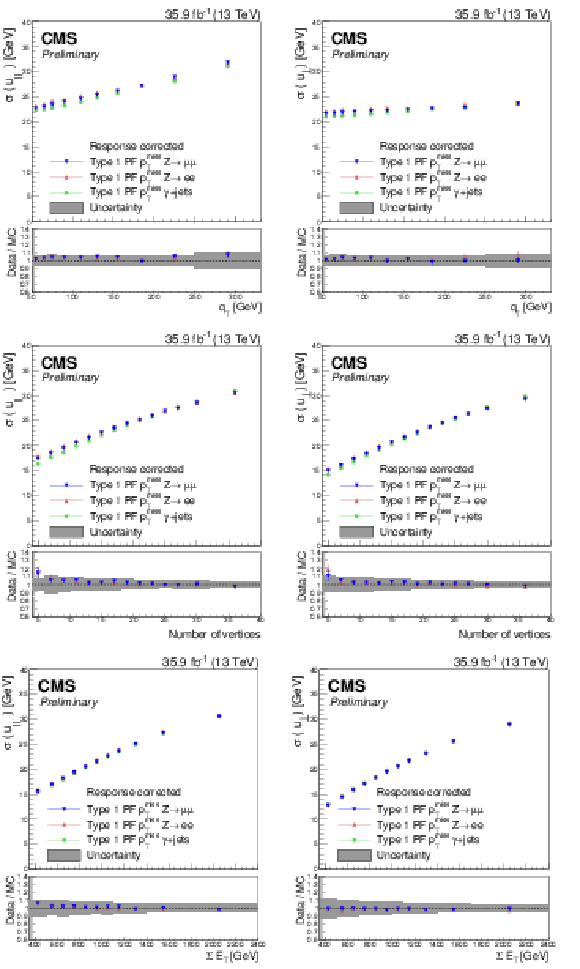
png pdf |
Figure 11:
Resolution of the {u_{^\circ}limiter "026B30D} and {u_\perp} components of the hadronic recoil as a function of, {{q}_{\rm T}} (top row), the reconstructed primary vertices (middle row), and the scalar {p_{\mathrm {T}}} sum of all PF candidates (bottom row), in {{\mathrm {Z}}\to \mu ^+\mu ^-}, {{\mathrm {Z}}\to e^+e^-}and {\gamma} events. In each plot, the upper panel shows the resolution in data, whereas the lower panel shows the ratio of data to simulation. The gray band corresponds to the systematic uncertainty due to the jet energy scale, jet energy resolution and variations on the unclustered energy, estimated from the {{\mathrm {Z}}\to e^+e^-}sample. |

png pdf |
Figure 11-a:
Resolution of the {u_{^\circ}limiter "026B30D} and {u_\perp} components of the hadronic recoil as a function of, {{q}_{\rm T}} (top row), the reconstructed primary vertices (middle row), and the scalar {p_{\mathrm {T}}} sum of all PF candidates (bottom row), in {{\mathrm {Z}}\to \mu ^+\mu ^-}, {{\mathrm {Z}}\to e^+e^-}and {\gamma} events. In each plot, the upper panel shows the resolution in data, whereas the lower panel shows the ratio of data to simulation. The gray band corresponds to the systematic uncertainty due to the jet energy scale, jet energy resolution and variations on the unclustered energy, estimated from the {{\mathrm {Z}}\to e^+e^-}sample. |

png pdf |
Figure 11-b:
Resolution of the {u_{^\circ}limiter "026B30D} and {u_\perp} components of the hadronic recoil as a function of, {{q}_{\rm T}} (top row), the reconstructed primary vertices (middle row), and the scalar {p_{\mathrm {T}}} sum of all PF candidates (bottom row), in {{\mathrm {Z}}\to \mu ^+\mu ^-}, {{\mathrm {Z}}\to e^+e^-}and {\gamma} events. In each plot, the upper panel shows the resolution in data, whereas the lower panel shows the ratio of data to simulation. The gray band corresponds to the systematic uncertainty due to the jet energy scale, jet energy resolution and variations on the unclustered energy, estimated from the {{\mathrm {Z}}\to e^+e^-}sample. |

png pdf |
Figure 11-c:
Resolution of the {u_{^\circ}limiter "026B30D} and {u_\perp} components of the hadronic recoil as a function of, {{q}_{\rm T}} (top row), the reconstructed primary vertices (middle row), and the scalar {p_{\mathrm {T}}} sum of all PF candidates (bottom row), in {{\mathrm {Z}}\to \mu ^+\mu ^-}, {{\mathrm {Z}}\to e^+e^-}and {\gamma} events. In each plot, the upper panel shows the resolution in data, whereas the lower panel shows the ratio of data to simulation. The gray band corresponds to the systematic uncertainty due to the jet energy scale, jet energy resolution and variations on the unclustered energy, estimated from the {{\mathrm {Z}}\to e^+e^-}sample. |

png pdf |
Figure 11-d:
Resolution of the {u_{^\circ}limiter "026B30D} and {u_\perp} components of the hadronic recoil as a function of, {{q}_{\rm T}} (top row), the reconstructed primary vertices (middle row), and the scalar {p_{\mathrm {T}}} sum of all PF candidates (bottom row), in {{\mathrm {Z}}\to \mu ^+\mu ^-}, {{\mathrm {Z}}\to e^+e^-}and {\gamma} events. In each plot, the upper panel shows the resolution in data, whereas the lower panel shows the ratio of data to simulation. The gray band corresponds to the systematic uncertainty due to the jet energy scale, jet energy resolution and variations on the unclustered energy, estimated from the {{\mathrm {Z}}\to e^+e^-}sample. |

png pdf |
Figure 11-e:
Resolution of the {u_{^\circ}limiter "026B30D} and {u_\perp} components of the hadronic recoil as a function of, {{q}_{\rm T}} (top row), the reconstructed primary vertices (middle row), and the scalar {p_{\mathrm {T}}} sum of all PF candidates (bottom row), in {{\mathrm {Z}}\to \mu ^+\mu ^-}, {{\mathrm {Z}}\to e^+e^-}and {\gamma} events. In each plot, the upper panel shows the resolution in data, whereas the lower panel shows the ratio of data to simulation. The gray band corresponds to the systematic uncertainty due to the jet energy scale, jet energy resolution and variations on the unclustered energy, estimated from the {{\mathrm {Z}}\to e^+e^-}sample. |

png pdf |
Figure 11-f:
Resolution of the {u_{^\circ}limiter "026B30D} and {u_\perp} components of the hadronic recoil as a function of, {{q}_{\rm T}} (top row), the reconstructed primary vertices (middle row), and the scalar {p_{\mathrm {T}}} sum of all PF candidates (bottom row), in {{\mathrm {Z}}\to \mu ^+\mu ^-}, {{\mathrm {Z}}\to e^+e^-}and {\gamma} events. In each plot, the upper panel shows the resolution in data, whereas the lower panel shows the ratio of data to simulation. The gray band corresponds to the systematic uncertainty due to the jet energy scale, jet energy resolution and variations on the unclustered energy, estimated from the {{\mathrm {Z}}\to e^+e^-}sample. |
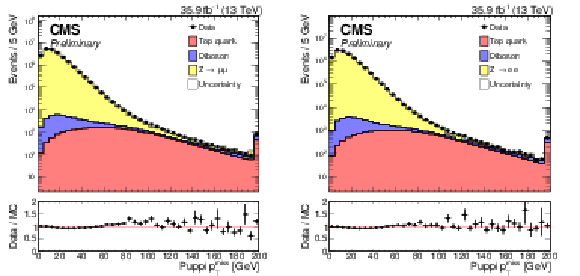
png pdf |
Figure 12:
Upper panel: Distributions of {\text {Puppi}} {{p_{\mathrm {T}}} ^\text {miss}} in {{\mathrm {Z}}\to \mu ^+\mu ^-}(left) and {{\mathrm {Z}}\to e^+e^-}(right). The last bin shown, includes the overflow content. Lower panel: Data to simulation ratio. The systematic uncertainty due to the jet energy scale, jet energy resolution and variations on the unclustered energy is displayed with a gray band. |

png pdf |
Figure 12-a:
Upper panel: Distributions of {\text {Puppi}} {{p_{\mathrm {T}}} ^\text {miss}} in {{\mathrm {Z}}\to \mu ^+\mu ^-}(left) and {{\mathrm {Z}}\to e^+e^-}(right). The last bin shown, includes the overflow content. Lower panel: Data to simulation ratio. The systematic uncertainty due to the jet energy scale, jet energy resolution and variations on the unclustered energy is displayed with a gray band. |
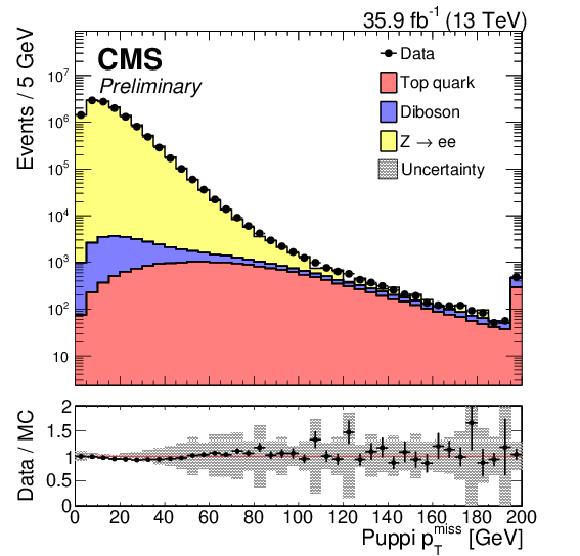
png pdf |
Figure 12-b:
Upper panel: Distributions of {\text {Puppi}} {{p_{\mathrm {T}}} ^\text {miss}} in {{\mathrm {Z}}\to \mu ^+\mu ^-}(left) and {{\mathrm {Z}}\to e^+e^-}(right). The last bin shown, includes the overflow content. Lower panel: Data to simulation ratio. The systematic uncertainty due to the jet energy scale, jet energy resolution and variations on the unclustered energy is displayed with a gray band. |

png pdf |
Figure 13:
Upper panel: Distributions of the {u_{^\circ}limiter "026B30D} + {{q}_{\rm T}} and {u_\perp} components of the hadronic recoil, in data (filled markers) and simulation (solid histograms) for the {{\mathrm {Z}}\to \mu ^+\mu ^-}(upper) and {{\mathrm {Z}}\to e^+e^-}(lower) samples. The first and the last bins include the underflow and overflow content, respectively. Lower panel: Data to simulation ratio. The systematic uncertainty due to the jet energy scale, jet energy resolution and variations on the unclustered energy is displayed with a gray band. |

png pdf |
Figure 13-a:
Upper panel: Distributions of the {u_{^\circ}limiter "026B30D} + {{q}_{\rm T}} and {u_\perp} components of the hadronic recoil, in data (filled markers) and simulation (solid histograms) for the {{\mathrm {Z}}\to \mu ^+\mu ^-}(upper) and {{\mathrm {Z}}\to e^+e^-}(lower) samples. The first and the last bins include the underflow and overflow content, respectively. Lower panel: Data to simulation ratio. The systematic uncertainty due to the jet energy scale, jet energy resolution and variations on the unclustered energy is displayed with a gray band. |
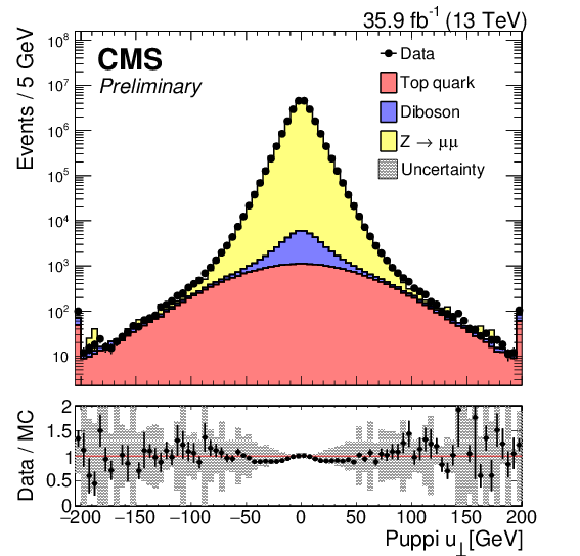
png pdf |
Figure 13-b:
Upper panel: Distributions of the {u_{^\circ}limiter "026B30D} + {{q}_{\rm T}} and {u_\perp} components of the hadronic recoil, in data (filled markers) and simulation (solid histograms) for the {{\mathrm {Z}}\to \mu ^+\mu ^-}(upper) and {{\mathrm {Z}}\to e^+e^-}(lower) samples. The first and the last bins include the underflow and overflow content, respectively. Lower panel: Data to simulation ratio. The systematic uncertainty due to the jet energy scale, jet energy resolution and variations on the unclustered energy is displayed with a gray band. |

png pdf |
Figure 13-c:
Upper panel: Distributions of the {u_{^\circ}limiter "026B30D} + {{q}_{\rm T}} and {u_\perp} components of the hadronic recoil, in data (filled markers) and simulation (solid histograms) for the {{\mathrm {Z}}\to \mu ^+\mu ^-}(upper) and {{\mathrm {Z}}\to e^+e^-}(lower) samples. The first and the last bins include the underflow and overflow content, respectively. Lower panel: Data to simulation ratio. The systematic uncertainty due to the jet energy scale, jet energy resolution and variations on the unclustered energy is displayed with a gray band. |
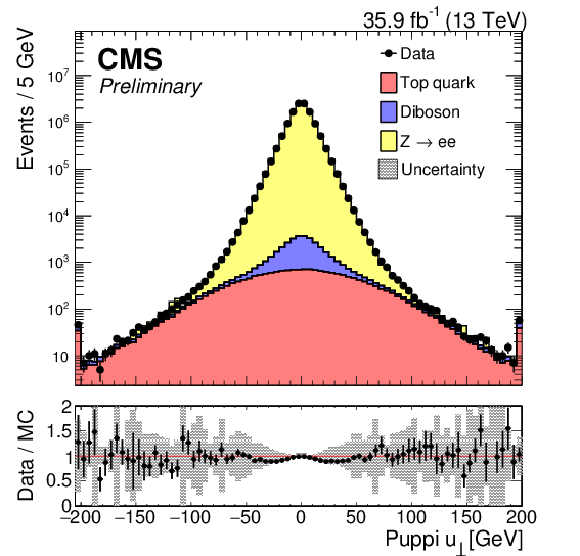
png pdf |
Figure 13-d:
Upper panel: Distributions of the {u_{^\circ}limiter "026B30D} + {{q}_{\rm T}} and {u_\perp} components of the hadronic recoil, in data (filled markers) and simulation (solid histograms) for the {{\mathrm {Z}}\to \mu ^+\mu ^-}(upper) and {{\mathrm {Z}}\to e^+e^-}(lower) samples. The first and the last bins include the underflow and overflow content, respectively. Lower panel: Data to simulation ratio. The systematic uncertainty due to the jet energy scale, jet energy resolution and variations on the unclustered energy is displayed with a gray band. |

png pdf |
Figure 14:
Upper panel: Response of {\text {Puppi}} {{p_{\mathrm {T}}} ^\text {miss}} in data in {{\mathrm {Z}}\to \mu ^+\mu ^-}and {{\mathrm {Z}}\to e^+e^-}events. Lower panel: ratio of the {\text {Puppi}} {{p_{\mathrm {T}}} ^\text {miss}} response in data and simulation. The systematic uncertainty due to the jet energy scale, jet energy resolution and variations on the unclustered energy is displayed with a gray band. |

png pdf |
Figure 15:
{\text {Puppi}} {{p_{\mathrm {T}}} ^\text {miss}} resolution of the {u_{^\circ}limiter "026B30D} (left) and {u_\perp} (right) components of the hadronic recoil as a function of reconstructed primary vertices in {{\mathrm {Z}}\to \mu ^+\mu ^-}and {{\mathrm {Z}}\to e^+e^-}events. In each plot, the upper panel shows the resolution in data, whereas the lower panel shows the ratio of data to simulation. The systematic uncertainty due to the jet energy scale, jet energy resolution and variations on the unclustered energy is displayed with a gray band. |
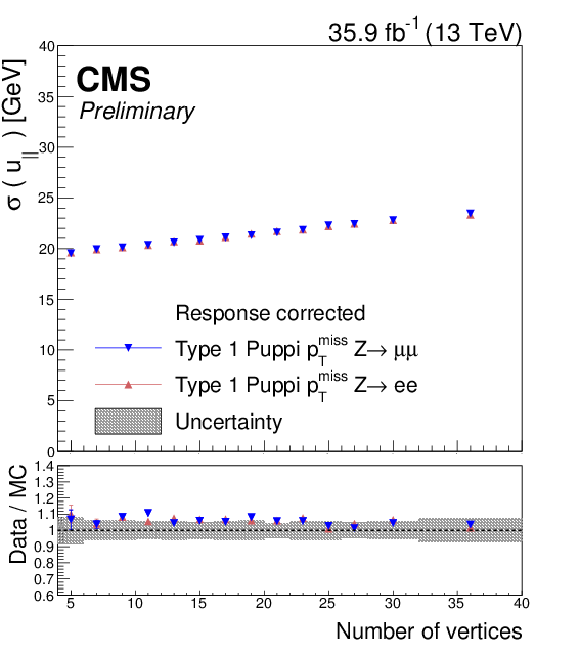
png pdf |
Figure 15-a:
{\text {Puppi}} {{p_{\mathrm {T}}} ^\text {miss}} resolution of the {u_{^\circ}limiter "026B30D} (left) and {u_\perp} (right) components of the hadronic recoil as a function of reconstructed primary vertices in {{\mathrm {Z}}\to \mu ^+\mu ^-}and {{\mathrm {Z}}\to e^+e^-}events. In each plot, the upper panel shows the resolution in data, whereas the lower panel shows the ratio of data to simulation. The systematic uncertainty due to the jet energy scale, jet energy resolution and variations on the unclustered energy is displayed with a gray band. |

png pdf |
Figure 15-b:
{\text {Puppi}} {{p_{\mathrm {T}}} ^\text {miss}} resolution of the {u_{^\circ}limiter "026B30D} (left) and {u_\perp} (right) components of the hadronic recoil as a function of reconstructed primary vertices in {{\mathrm {Z}}\to \mu ^+\mu ^-}and {{\mathrm {Z}}\to e^+e^-}events. In each plot, the upper panel shows the resolution in data, whereas the lower panel shows the ratio of data to simulation. The systematic uncertainty due to the jet energy scale, jet energy resolution and variations on the unclustered energy is displayed with a gray band. |
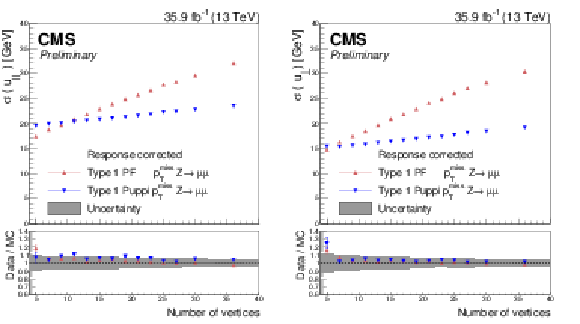
png pdf |
Figure 16:
Upper panel: Resolution of {u_{^\circ}limiter "026B30D} (left) and {u_\perp} (right) components of the hadronic recoil as function of the reconstructed vertices. The blue (yellow) markers correspond to the PF {{p_{\mathrm {T}}} ^\text {miss}} reconstruction algorithm for the nominal (high pileup) data, whereas the green (magenta) markers correspond to the {\text {Puppi}} {{p_{\mathrm {T}}} ^\text {miss}} reconstruction algorithm for the nominal (high pileup) data. The results are obtained after correcting for the difference in the response seen between the two algorithms. Lower panel: Data to simulation ratio. The systematic uncertainty due to the jet energy scale, jet energy resolution and variations on the unclustered energy is displayed with a gray band. |
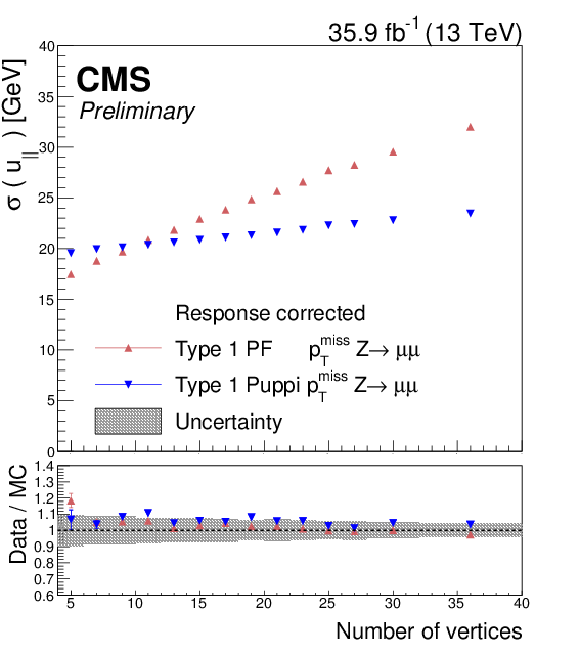
png pdf |
Figure 16-a:
Upper panel: Resolution of {u_{^\circ}limiter "026B30D} (left) and {u_\perp} (right) components of the hadronic recoil as function of the reconstructed vertices. The blue (yellow) markers correspond to the PF {{p_{\mathrm {T}}} ^\text {miss}} reconstruction algorithm for the nominal (high pileup) data, whereas the green (magenta) markers correspond to the {\text {Puppi}} {{p_{\mathrm {T}}} ^\text {miss}} reconstruction algorithm for the nominal (high pileup) data. The results are obtained after correcting for the difference in the response seen between the two algorithms. Lower panel: Data to simulation ratio. The systematic uncertainty due to the jet energy scale, jet energy resolution and variations on the unclustered energy is displayed with a gray band. |

png pdf |
Figure 16-b:
Upper panel: Resolution of {u_{^\circ}limiter "026B30D} (left) and {u_\perp} (right) components of the hadronic recoil as function of the reconstructed vertices. The blue (yellow) markers correspond to the PF {{p_{\mathrm {T}}} ^\text {miss}} reconstruction algorithm for the nominal (high pileup) data, whereas the green (magenta) markers correspond to the {\text {Puppi}} {{p_{\mathrm {T}}} ^\text {miss}} reconstruction algorithm for the nominal (high pileup) data. The results are obtained after correcting for the difference in the response seen between the two algorithms. Lower panel: Data to simulation ratio. The systematic uncertainty due to the jet energy scale, jet energy resolution and variations on the unclustered energy is displayed with a gray band. |
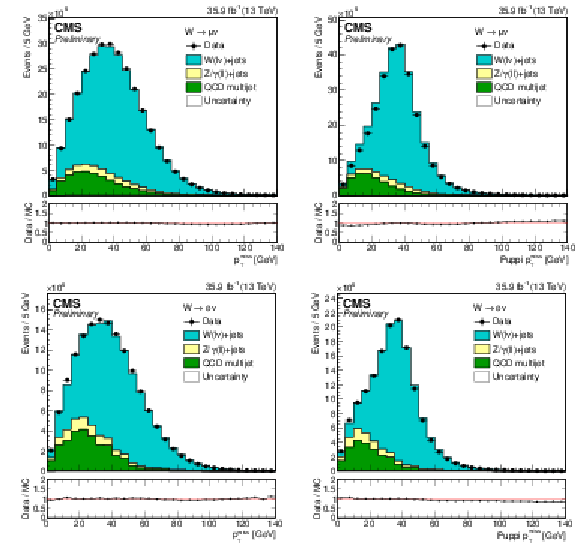
png pdf |
Figure 17:
PF (left) and {\text {Puppi}} (right) {{p_{\mathrm {T}}} ^\text {miss}} distribution is shown for single-muon (top) and single-electron (bottom) events. In all the distributions, the lower panel shows the ratio of data to simulation. The systematic uncertainty due to the jet energy scale, jet energy resolution and variations on the unclustered energy is displayed with a gray band. |

png pdf |
Figure 17-a:
PF (left) and {\text {Puppi}} (right) {{p_{\mathrm {T}}} ^\text {miss}} distribution is shown for single-muon (top) and single-electron (bottom) events. In all the distributions, the lower panel shows the ratio of data to simulation. The systematic uncertainty due to the jet energy scale, jet energy resolution and variations on the unclustered energy is displayed with a gray band. |

png pdf |
Figure 17-b:
PF (left) and {\text {Puppi}} (right) {{p_{\mathrm {T}}} ^\text {miss}} distribution is shown for single-muon (top) and single-electron (bottom) events. In all the distributions, the lower panel shows the ratio of data to simulation. The systematic uncertainty due to the jet energy scale, jet energy resolution and variations on the unclustered energy is displayed with a gray band. |
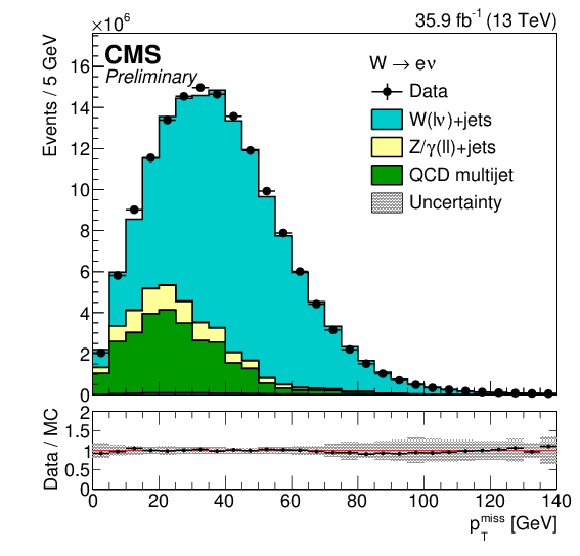
png pdf |
Figure 17-c:
PF (left) and {\text {Puppi}} (right) {{p_{\mathrm {T}}} ^\text {miss}} distribution is shown for single-muon (top) and single-electron (bottom) events. In all the distributions, the lower panel shows the ratio of data to simulation. The systematic uncertainty due to the jet energy scale, jet energy resolution and variations on the unclustered energy is displayed with a gray band. |
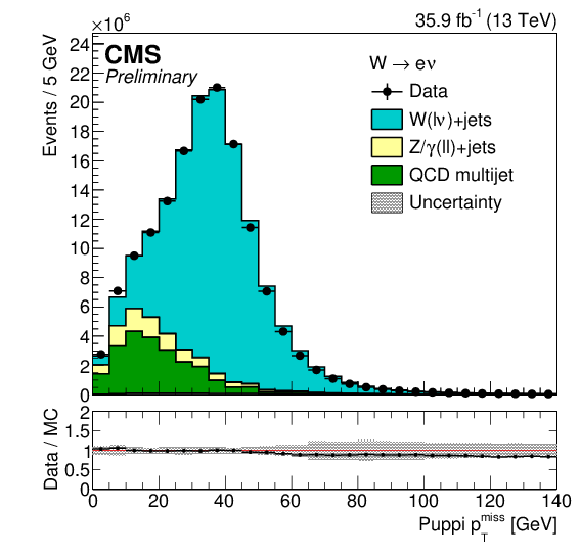
png pdf |
Figure 17-d:
PF (left) and {\text {Puppi}} (right) {{p_{\mathrm {T}}} ^\text {miss}} distribution is shown for single-muon (top) and single-electron (bottom) events. In all the distributions, the lower panel shows the ratio of data to simulation. The systematic uncertainty due to the jet energy scale, jet energy resolution and variations on the unclustered energy is displayed with a gray band. |
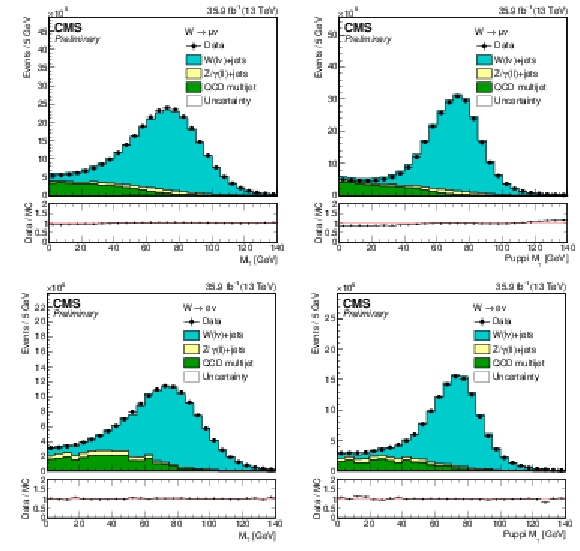
png pdf |
Figure 18:
PF (left) and {\text {Puppi}} (right) {M_\mathrm {T}}distribution is shown for single-muon (top) and single-electron (bottom) events. In all the distributions, the lower panel shows the ratio of data to simulation. The systematic uncertainty due to the jet energy scale, jet energy resolution and variations on the unclustered energy is displayed with a gray band. |

png pdf |
Figure 18-a:
PF (left) and {\text {Puppi}} (right) {M_\mathrm {T}}distribution is shown for single-muon (top) and single-electron (bottom) events. In all the distributions, the lower panel shows the ratio of data to simulation. The systematic uncertainty due to the jet energy scale, jet energy resolution and variations on the unclustered energy is displayed with a gray band. |

png pdf |
Figure 18-b:
PF (left) and {\text {Puppi}} (right) {M_\mathrm {T}}distribution is shown for single-muon (top) and single-electron (bottom) events. In all the distributions, the lower panel shows the ratio of data to simulation. The systematic uncertainty due to the jet energy scale, jet energy resolution and variations on the unclustered energy is displayed with a gray band. |
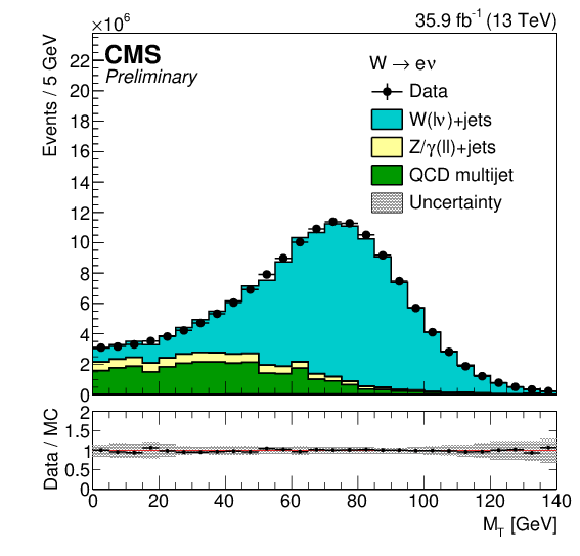
png pdf |
Figure 18-c:
PF (left) and {\text {Puppi}} (right) {M_\mathrm {T}}distribution is shown for single-muon (top) and single-electron (bottom) events. In all the distributions, the lower panel shows the ratio of data to simulation. The systematic uncertainty due to the jet energy scale, jet energy resolution and variations on the unclustered energy is displayed with a gray band. |

png pdf |
Figure 18-d:
PF (left) and {\text {Puppi}} (right) {M_\mathrm {T}}distribution is shown for single-muon (top) and single-electron (bottom) events. In all the distributions, the lower panel shows the ratio of data to simulation. The systematic uncertainty due to the jet energy scale, jet energy resolution and variations on the unclustered energy is displayed with a gray band. |
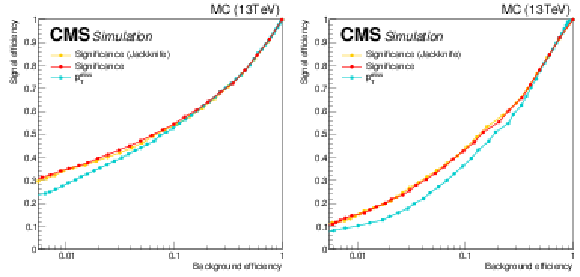
png pdf |
Figure 19:
ROC curves comparing the signal versus background efficiency for the the standard version of {{\mathcal S}}\ (red line), the jackknife version of {{\mathcal S}}\ (yellow line), and {{p_{\mathrm {T}}} ^\text {miss}} (cyan line) using simulated dimuon events (left) and single-electron events (right). Similar performance is observed between the two versions of {{\mathcal S}}. The {{\mathcal S}}\ performs better than {{p_{\mathrm {T}}} ^\text {miss}} especially in regions with small background efficiency. |

png pdf |
Figure 19-a:
ROC curves comparing the signal versus background efficiency for the the standard version of {{\mathcal S}}\ (red line), the jackknife version of {{\mathcal S}}\ (yellow line), and {{p_{\mathrm {T}}} ^\text {miss}} (cyan line) using simulated dimuon events (left) and single-electron events (right). Similar performance is observed between the two versions of {{\mathcal S}}. The {{\mathcal S}}\ performs better than {{p_{\mathrm {T}}} ^\text {miss}} especially in regions with small background efficiency. |
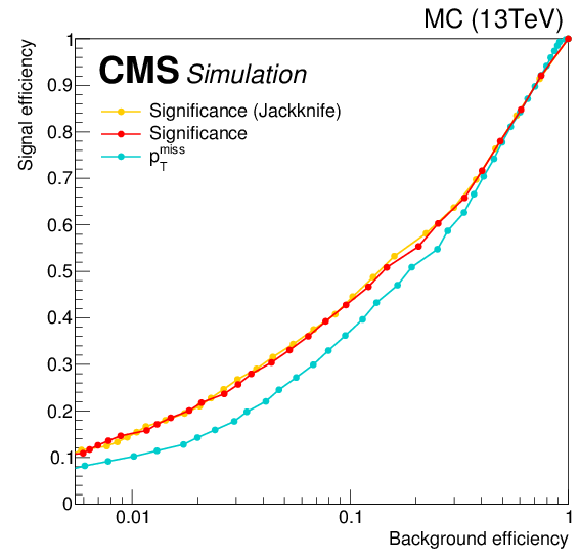
png pdf |
Figure 19-b:
ROC curves comparing the signal versus background efficiency for the the standard version of {{\mathcal S}}\ (red line), the jackknife version of {{\mathcal S}}\ (yellow line), and {{p_{\mathrm {T}}} ^\text {miss}} (cyan line) using simulated dimuon events (left) and single-electron events (right). Similar performance is observed between the two versions of {{\mathcal S}}. The {{\mathcal S}}\ performs better than {{p_{\mathrm {T}}} ^\text {miss}} especially in regions with small background efficiency. |

png pdf |
Figure 20:
Distributions of {{\mathcal S}}\ in data and simulation in dimuon (top) and dielectron (bottom) for events with 0 (left) and $\geq $ 1 jet (left). The red straight line corresponds to a $\chi ^2$ distribution of 2 degrees of freedom. The bands in the bottom panel display the effect of various sources of systematic uncertainties in simulation. Good agreement between data and simulation is observed. |

png pdf |
Figure 20-a:
Distributions of {{\mathcal S}}\ in data and simulation in dimuon (top) and dielectron (bottom) for events with 0 (left) and $\geq $ 1 jet (left). The red straight line corresponds to a $\chi ^2$ distribution of 2 degrees of freedom. The bands in the bottom panel display the effect of various sources of systematic uncertainties in simulation. Good agreement between data and simulation is observed. |

png pdf |
Figure 20-b:
Distributions of {{\mathcal S}}\ in data and simulation in dimuon (top) and dielectron (bottom) for events with 0 (left) and $\geq $ 1 jet (left). The red straight line corresponds to a $\chi ^2$ distribution of 2 degrees of freedom. The bands in the bottom panel display the effect of various sources of systematic uncertainties in simulation. Good agreement between data and simulation is observed. |

png pdf |
Figure 20-c:
Distributions of {{\mathcal S}}\ in data and simulation in dimuon (top) and dielectron (bottom) for events with 0 (left) and $\geq $ 1 jet (left). The red straight line corresponds to a $\chi ^2$ distribution of 2 degrees of freedom. The bands in the bottom panel display the effect of various sources of systematic uncertainties in simulation. Good agreement between data and simulation is observed. |

png pdf |
Figure 20-d:
Distributions of {{\mathcal S}}\ in data and simulation in dimuon (top) and dielectron (bottom) for events with 0 (left) and $\geq $ 1 jet (left). The red straight line corresponds to a $\chi ^2$ distribution of 2 degrees of freedom. The bands in the bottom panel display the effect of various sources of systematic uncertainties in simulation. Good agreement between data and simulation is observed. |

png pdf |
Figure 21:
Distributions of {{\mathcal S}}\ in data and simulation in single-muon (top) and single-electron (bottom) for events with 0 (left) and $\geq $ 1 jet (left). The red straight line corresponds to a $\chi ^2$ distribution of 2 degrees of freedom. The bands in the bottom panel display the effect of various sources of systematic uncertainties in simulation. Good agreement between data and simulation is observed. |
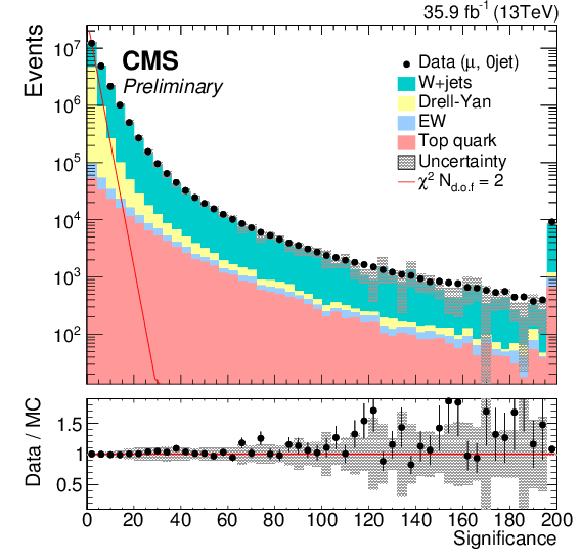
png pdf |
Figure 21-a:
Distributions of {{\mathcal S}}\ in data and simulation in single-muon (top) and single-electron (bottom) for events with 0 (left) and $\geq $ 1 jet (left). The red straight line corresponds to a $\chi ^2$ distribution of 2 degrees of freedom. The bands in the bottom panel display the effect of various sources of systematic uncertainties in simulation. Good agreement between data and simulation is observed. |
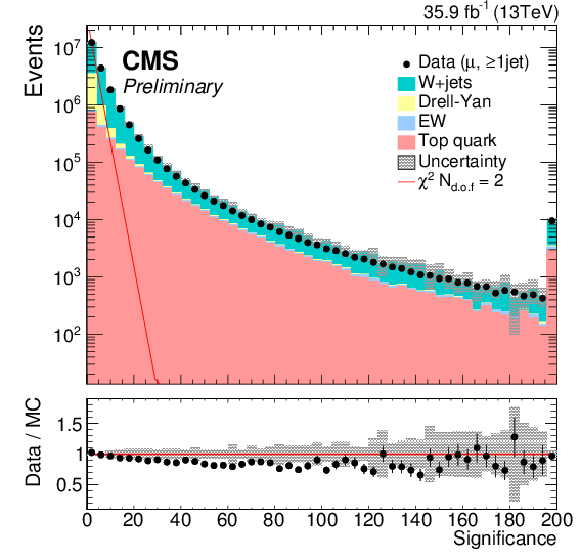
png pdf |
Figure 21-b:
Distributions of {{\mathcal S}}\ in data and simulation in single-muon (top) and single-electron (bottom) for events with 0 (left) and $\geq $ 1 jet (left). The red straight line corresponds to a $\chi ^2$ distribution of 2 degrees of freedom. The bands in the bottom panel display the effect of various sources of systematic uncertainties in simulation. Good agreement between data and simulation is observed. |

png pdf |
Figure 21-c:
Distributions of {{\mathcal S}}\ in data and simulation in single-muon (top) and single-electron (bottom) for events with 0 (left) and $\geq $ 1 jet (left). The red straight line corresponds to a $\chi ^2$ distribution of 2 degrees of freedom. The bands in the bottom panel display the effect of various sources of systematic uncertainties in simulation. Good agreement between data and simulation is observed. |
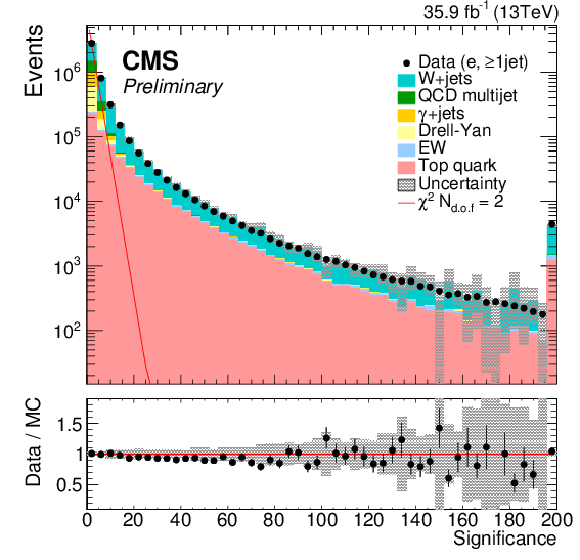
png pdf |
Figure 21-d:
Distributions of {{\mathcal S}}\ in data and simulation in single-muon (top) and single-electron (bottom) for events with 0 (left) and $\geq $ 1 jet (left). The red straight line corresponds to a $\chi ^2$ distribution of 2 degrees of freedom. The bands in the bottom panel display the effect of various sources of systematic uncertainties in simulation. Good agreement between data and simulation is observed. |

png pdf |
Figure 22:
Dependence of the average {{\mathcal S}}\ on pileup, for dimuon events (left) and single-electron events (right). Small dependence is observed for processes with no genuine {{p_{\mathrm {T}}} ^\text {miss}}, whereas in events with intrinsic {{p_{\mathrm {T}}} ^\text {miss}} the behavior of {{\mathcal S}}\ depends strongly on vertex multiplicity. |

png pdf |
Figure 22-a:
Dependence of the average {{\mathcal S}}\ on pileup, for dimuon events (left) and single-electron events (right). Small dependence is observed for processes with no genuine {{p_{\mathrm {T}}} ^\text {miss}}, whereas in events with intrinsic {{p_{\mathrm {T}}} ^\text {miss}} the behavior of {{\mathcal S}}\ depends strongly on vertex multiplicity. |
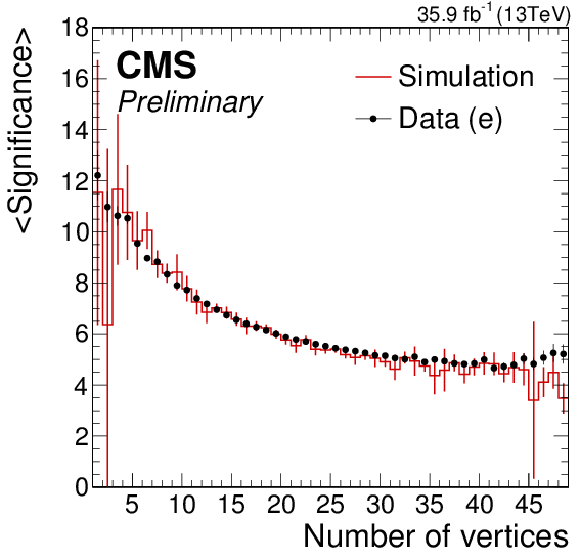
png pdf |
Figure 22-b:
Dependence of the average {{\mathcal S}}\ on pileup, for dimuon events (left) and single-electron events (right). Small dependence is observed for processes with no genuine {{p_{\mathrm {T}}} ^\text {miss}}, whereas in events with intrinsic {{p_{\mathrm {T}}} ^\text {miss}} the behavior of {{\mathcal S}}\ depends strongly on vertex multiplicity. |
| Tables | |

png pdf |
Table 1:
List of the functional form of the resolution in the {p_{\mathrm {T}}} measurement for each PF candidate class contributing to the unclustered energy. |

png pdf |
Table 2:
Parametrization results of the resolution curves for {u_{^\circ}limiter "026B30D} and {u_\perp} components as a function of number of reconstructed vertices. The parameter values for $\sigma _{\mathrm {c}}$ are obtained from data and simulation, and the values for $\sigma _{\mathrm {\mathrm {PU}}}$ are obtained from data, along with a ratio $R_{\mathrm {PU}}$ of data and simulation. The uncertainties displayed for both the quantities are obtained from the fit, and for simulation the jet energy scale, jet energy resolution and unclustered energy uncertainties are propagated. |

png pdf |
Table 3:
Parametrization results of the resolution curves for {u_{^\circ}limiter "026B30D} and {u_\perp} components as a function of the scalar {p_{\mathrm {T}}} sum of all PF candidates. The parameter values for $\sigma _{\mathrm {0}}$ are obtained from data and simulation, whereas the $\sigma _{s}$ are obtained from data along with a ratio $R_{\mathrm {s}}$, the ratio of data and simulation. The uncertainties displayed for both the quantities are obtained from the fit, and for simulation the jet energy scale, jet energy resolution and unclustered energy uncertainties are propagated. |

png pdf |
Table 4:
Parametrization results of the resolution curves for {\text {Puppi}} {u_{^\circ}limiter "026B30D} and {u_\perp} components as a function of number of reconstructed vertices. The parameter values for $\sigma _{\mathrm {c}}$ are obtained from data and simulation, and the values for $\sigma _{\mathrm {\mathrm {PU}}}$ are obtained from data, along with a ratio $R_{\mathrm {PU}}$ of data and simulation. The uncertainties displayed for both the quantities are obtained from the fit, and for simulation the jet energy scale, jet energy resolution and unclustered energy uncertainties are propagated. |
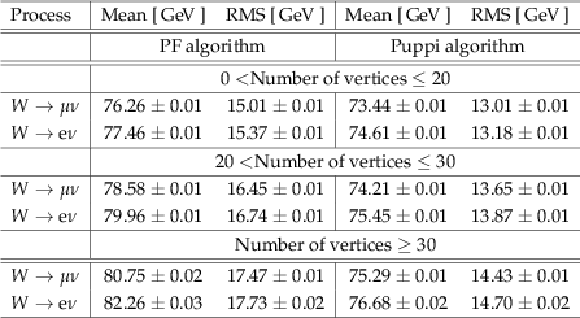
png pdf |
Table 5:
The summary of the mean and the spread of the Jacobian mass peak on the {M_\mathrm {T}}\nobreakspace {}distribution in single lepton events for PF and {\text {Puppi}} {{p_{\mathrm {T}}} ^\text {miss}} algorithms. The results are obtained using simulated W+jets events. |
| Summary |
|
The performance of missing transverse momentum ({p_{\mathrm{T}}}miss) reconstruction algorithms is presented using events with and without intrinsic missing transverse momentum in proton-proton collisions recorded at $\sqrt{s} = 13$ TeV, using a sample of data corresponding to an integrated luminosity of 35.9 fb$^{-1}$. The performance of algorithms used to identify and remove events with anomalous missing transverse momentum have been also studied using events with one or more jets. The scale and resolution of the missing transverse momentum determination has been measured using events with an identified \mathrm{Z} boson or isolated photon. The measured scale and resolution in data are found to be in agreement with the expectations from the simulation. The performance of an advanced {p_{\mathrm{T}}}miss reconstruction algorithm, the {\text{Puppi}} {p_{\mathrm{T}}}miss, specifically developed to cope with a large number of pileup interactions has also been presented. This algorithm shows a significantly reduced dependence of the {p_{\mathrm{T}}}miss resolution on pileup interactions. The studies presented in this note provide a solid foundation for all CMS measurements with {p_{\mathrm{T}}}miss in the final state, including standard model measurements of the Higgs boson, W boson and top quark and searches for new neutral weakly interacting particles beyond the standard model. |
| References | ||||
| 1 | CMS Collaboration | The CMS experiment at the CERN LHC | JINST 3 (2008) S08004 | CMS-00-001 |
| 2 | L. Evans and P. Bryant (editors) | LHC Machine | JINST 3 (2008) S08001 | |
| 3 | CMS Collaboration | The CMS experiment at the CERN LHC | JINST 3 (2008) S08004 | CMS-00-001 |
| 4 | CMS Collaboration | Description and performance of track and primary-vertex reconstruction with the CMS tracker | JINST 9 (2014) P10009 | CMS-TRK-11-001 1405.6569 |
| 5 | CMS Collaboration | The CMS trigger system | JINST 12 (2017), no. 01, P01020 | CMS-TRG-12-001 1609.02366 |
| 6 | CMS Collaboration | Particle-flow reconstruction and global event description with the cms detector | JINST 12 (2017) P10003 | CMS-PRF-14-001 1706.04965 |
| 7 | M. Cacciari, G. P. Salam, and G. Soyez | The anti-$ k_t $ jet clustering algorithm | JHEP 04 (2008) 063 | 0802.1189 |
| 8 | M. Cacciari, G. P. Salam, and G. Soyez | FastJet user manual | EPJC 72 (2012) 1896 | 1111.6097 |
| 9 | CMS Collaboration | Performance of photon reconstruction and identification with the CMS detector in proton-proton collisions at $ \sqrt{s} = $ 8 TeV | JINST 10 (2015) P08010 | CMS-EGM-14-001 1502.02702 |
| 10 | CMS Collaboration | Performance of Electron Reconstruction and Selection with the CMS Detector in Proton-Proton Collisions at √s = 8 TeV | JINST 10 (2015), no. 06, P06005 | CMS-EGM-13-001 1502.02701 |
| 11 | CMS Collaboration | Performance of CMS muon reconstruction in $ pp $ collision events at $ \sqrt{s} = $ 7 TeV | JINST 7 (2012) P10002 | CMS-MUO-10-004 1206.4071 |
| 12 | CMS Collaboration | Reconstruction and identification of $ \tau $ lepton decays to hadrons and $ \nu_{\tau} $ at CMS | JINST 11 (2016) P01019 | CMS-TAU-14-001 1510.07488 |
| 13 | CMS Collaboration | Jet energy scale and resolution in the CMS experiment in pp collisions at 8 TeV | JINST 12 (2017) P02014 | CMS-JME-13-004 1607.03663 |
| 14 | CMS Collaboration | Identification of heavy-flavour jets with the CMS detector in pp collisions at 13 TeV | Submitted to \it JINST | CMS-BTV-16-002 1712.07158 |
| 15 | CMS Collaboration | Missing transverse energy performance of the CMS detector | JINST 6 (2011) P09001 | CMS-JME-10-009 1106.5048 |
| 16 | CMS Collaboration | Performance of the CMS missing transverse momentum reconstruction in pp data at $ \sqrt{s} = $ 8 TeV | JINST 10 (2015), no. 02, P02006 | CMS-JME-13-003 1411.0511 |
| 17 | D. Bertolini, P. Harris, M. Low, and N. Tran | Pileup Per Particle Identification | JHEP 10 (2014) 059 | 1407.6013 |
| 18 | CMS Collaboration | Particle-flow reconstruction and global event description with the CMS detector | Submitted to JINST | CMS-PRF-14-001 1706.04965 |
| 19 | J. Alwall et al. | The automated computation of tree-level and next-to-leading order differential cross sections, and their matching to parton shower simulations | JHEP 07 (2014) 079 | 1405.0301 |
| 20 | C. Oleari | The POWHEG-BOX | NPPS 205-206 (2010) 36 | 1007.3893 |
| 21 | S. Alioli, P. Nason, C. Oleari, and E. Re | NLO single-top production matched with shower in POWHEG: s- and t-channel contributions | JHEP 09 (2009) 111 | 0907.4076 |
| 22 | T. Sjostrand et al. | An Introduction to PYTHIA 8.2 | CPC 191 (2015) 159--177 | 1410.3012 |
| 23 | CMS Collaboration | Event generator tunes obtained from underlying event and multiparton scattering measurements | EPJC 76 (2016) 155 | CMS-GEN-14-001 1512.00815 |
| 24 | M. L. Mangano, M. Moretti, F. Piccinini, and M. Treccani | Matching matrix elements and shower evolution for top-quark production in hadronic collisions | JHEP 01 (2007) 013 | hep-ph/0611129 |
| 25 | R. Frederix and S. Frixione | Merging meets matching in MC@NLO | JHEP 12 (2012) 061 | 1209.6215 |
| 26 | NNPDF Collaboration | Parton distributions for the LHC Run II | JHEP 04 (2015) 040 | 1410.8849 |
| 27 | GEANT4 Collaboration | GEANT4: A Simulation toolkit | NIMA506 (2003) 250 | |
| 28 | CMS Collaboration | CMS Luminosity Measurements for the 2016 Data Taking Period | CMS-PAS-LUM-17-001 | CMS-PAS-LUM-17-001 |
| 29 | CMS Collaboration | Missing transverse energy performance of the CMS detector | JINST 6 (2011) P09001 | CMS-JME-10-009 1106.5048 |
| 30 | CMS Collaboration | Identification and Filtering of Uncharacteristic Noise in the CMS Hadron Calorimeter | JINST 5 (2010) T03014 | CMS-CFT-09-019 0911.4881 |
| 31 | CMS Collaboration | 2017 Tracking Performance Plots | CDS | |
| 32 | M. H. Quenouille | Approximate tests of correlation in time-series | Journal of the Royal Statistical Society. Series B (Methodological) 11 (1949), no. 1, 68--84 | |
| 33 | J. Tukey | Bias and confidence in not quite large samples | Annals of Mathematical Statistics 29 (1958), no. 614, 1261--1295 | |

|
Compact Muon Solenoid LHC, CERN |

|

|

|

|

|

|